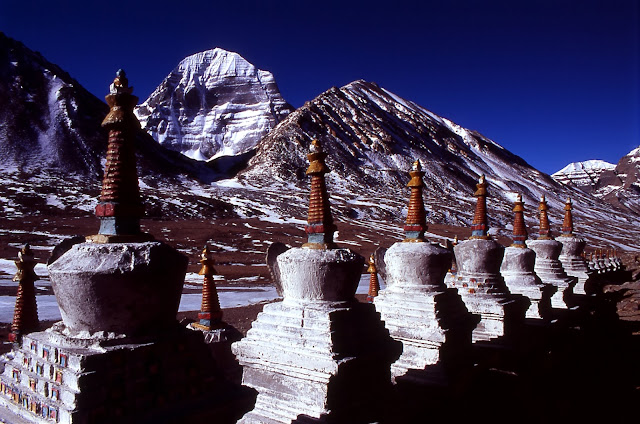 |
| Kailash Mansarovar Yatra |
The Kailash-Mansarovar
area is part of in the south-western tip of the Tibetean Plateau. In a way, it
is on the leeway side of the himalayas on the other side. If one were
to put a straight line from New Delhi to Kailash Manasarovar, it would be just
550 kms! But then, only crows and eagles would be able to tread this path. For
us humans, given the tough terrain, heights and frosty political climate, the
distance is much more- approx 900 kms. These days, though there are
organizations which take guided tours for the Kailash Mansarovar Yatra taking
good care of the participants.
The kailash parikrama or circumambulation of the Kailas Parvat is
about 54 kms.
Mt Kailash, revered amongst Hindus as the abode of Rudra, the
angry though benevolent and his consort Devi Parvati, overlooks the Mansarovar
at a distance of 32 kms with the Rakshas Tal to its south.
Mount Kailash is a peak
in the Kailash Range, part of the Trans-himalaya in Tibet.
With
its four facades facing north, east, south, and west, Mount Kailash looks like
an enormous diamond. Seventy-five percent as high as Mount Everest, the mountain
is one of the tallest peaks in the Himalayas. On its southern face, a vertical
gash crosses horizontal layers, creating the image of a swastika. The word
comes from svastika, Sanskrit for well-being and good fortune. Buddhists regard
the mountain as a mandala -— the sacred circle from which the sacred rivers
flow like the spokes of the eternal wheel. At
sunset the whole of the Kailash range on the north becomes a fiery region all of
a sudden, throwing an observer into a trance, and by the time he returns to
consciousness he sees only the Silvery Peak in front.
Manasa-sarovara is probably the holiest, most enchanting
amongst lakes, water bodies and pilgrimages. For its size, it is majestically
calm and dignified with hues of bluish green emerald color. It is set between
two mighty and equally majestic mountains, the Kailash to the north and the
Gurla Mandhata to the south. To its west is its sister lake Rakshas-Tal with
some hills to the east. Manasarovar is located at an impossible height of
approx 46000
meters (14950 feet). above sea level. Its vast expanse covers an area close to
90 kms in circumference and an are close to 320 sq kms with a crazy depth of
approx 90 meters! Ie approx 300 feet!! Winters turns this whole water body into
a solid block of ice. Come spring and it melts to reveal clear blue waters. It
has the distinction of being the highest fresh water lake in the world. By the
side of it, there are caves and areas where one can set camp.
During
the Kailash Mansarovar Yatra, weather overall is
unpredictable most of the year round. One moment you have scorching Sun, the
next moment it begins to hail and snow and shortly after having a nap and
coming out of your camp, you will see a clear blue sky and bright Sun above and
a bed of pearl-like hail and white snow on the ground.
·
Summers (May to August)
are very pleasant with moderate climate, with average around 15°C.
· Monsoons (September to November) are accompanied with little rain
falls and also temperature drops down to 10°C.
· Winters (December to April) are chilly days with average minimum
touching near 5°C. Minimum can touch sub zero levels to -15°C. Snow falls often
during winters.
In winter all mountains and river lakes are frozen and
covered with snow, so the time of yatra is from May to September. Indian
pilgrims visit from June to September in 16 batches. (30-40 in every batch). In
Pune, there are but a few seasoned operators Raghukul Holidays which take
regular batches for the Kailash
Mansarovar Yatra. Selected people
go through medical tests and other formalities before they do yatra in their
batches.
Sources :-
1) Wikipedia
2) Adishakti
--------------------x----------------------
Please feel free to post your comments below.
About Author :- Amit Kulkarni is the founder of Raghukul Holidays.












0 comments:
Post a Comment